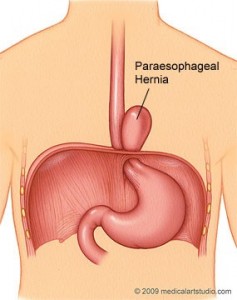What is hernia?
 Hernia means “the abnormal protrusion of an organ or its fascia through an opening or cavity in which it’s normally contained”. Hernia is of several types with specific treatments required for each.
Hernia means “the abnormal protrusion of an organ or its fascia through an opening or cavity in which it’s normally contained”. Hernia is of several types with specific treatments required for each.
Types of hernia:
Hernia maybe of following types:
– Inguinal hernia (direct or indirect): in which, the intestines (commonly) or urinary bladder protrude through the abdominal wall into the inguinal canal (in the region of groin). Common in men because of the natural weakness of abdominal wall inferiorly. Indirect is congenital, whereas direct is acquired and occurs after age of 40 years.
– Femoral hernia: common in females who are pregnant or obese. Occurs when intestines enter the femoral canal ( which is larger in females due to small size of their blood vessels).
– Umbilical hernia: when parts of intestines pass through abdominal wall near the tummy button. In infants commonly. May also commonly occur in females who have had several pregnancies.
– Hiatal hernia: due to shortened esophagus, the stomach tends to herniate through a diaphragmatic opening, through which normally the esophagus passes. This opening in the diaphragm is called esophageal hiatus and therefore the hernia is called hiatal hernia.
– Incisional hernia: incisional hernia occurs when there had already been an abdominal surgery. The intestines obtrude through the incisional site. Common in the elderly and obese individuals who have remained inactive after abdominal surgery.
– Diaphragmatic hernia: stomach cum intestines all jut through the diaphragm into the thoracic cavity causing difficulty in breathing. Seen in newborns. May be fatal.
– Herniation of intervertebral discs: when intervertebral discs protrude between two vertebrae.
Hernia Signs and symptoms
Different hernias carry different signs and symptoms. Common are: pain, bulges.
The commonest of hernias develop in abdomen. In these hernias, a bump is felt when intra-abdominal pressure increases as the person coughs or lifts heavy objects etc. other symptoms include pain in the groin region. Sometimes when the intestines are obstructed due to hernia, nausea or vomiting may present.
Spinal disc herniation– usually in the lumbar region may produce pain: sciatica, due to the compression of sciatic nerve that supplies muscles of lower limb.
Some hernias are congenital: diaphragmatic, hiatal; these cause gastroesophageal refluxes and therefore irritation of foregut.
What are the causes of hernia?
Causes vary in each individual.
For inguinal hernias, usually the weakness of the abdominal
wall contributes. This weakness may be because of poor nutrition, increased age, smoking, overexertion and incorrect posture.
Other causes may be: obesity, chronic lung disease (cough and increase in abdominal pressure), fluid in abdominal cavity, improper weight lifting (may be a cause of disc herniation).
A dislocation fracture of vertebra may also cause herniated discs to occur.
Hernia Treatment and prevention:
Therefore prevention methods like shunning from weight lifting, cutting extra weight, healthy diet intake are the best to consider.
Surgery is used to place back the jut organs commonly (aka “reducible” hernias). Surgeries again may expose to incisional hernia.